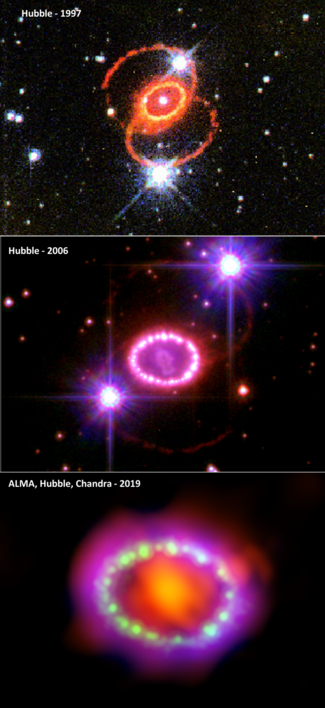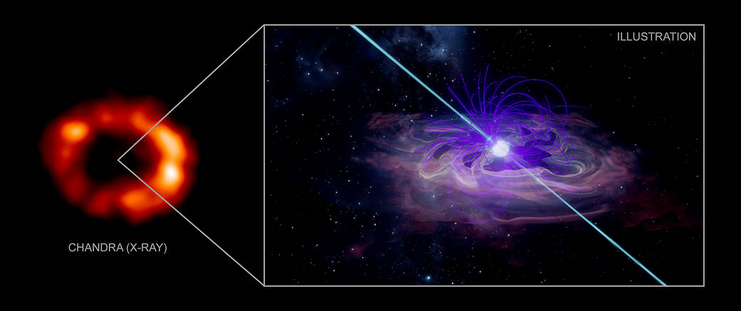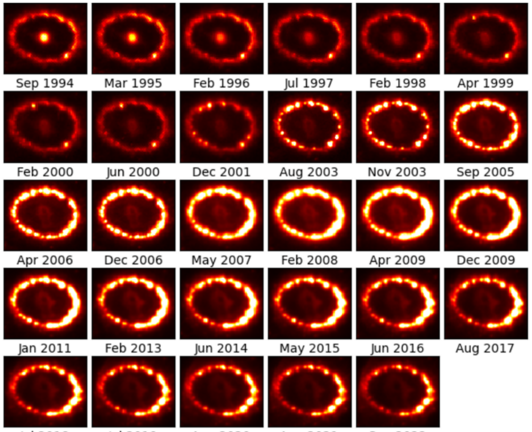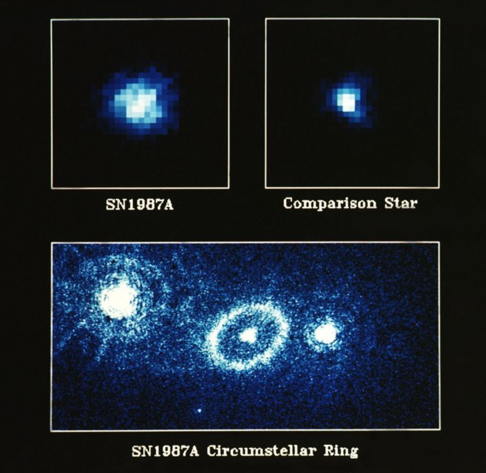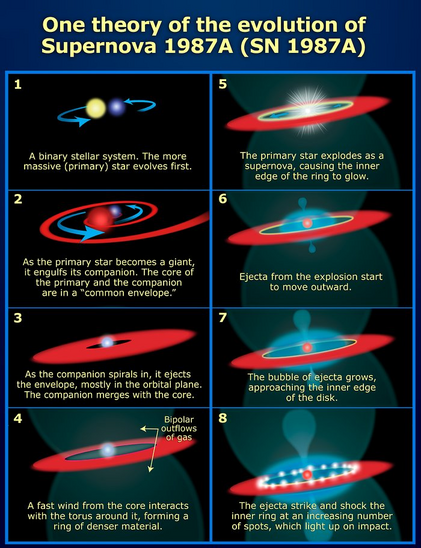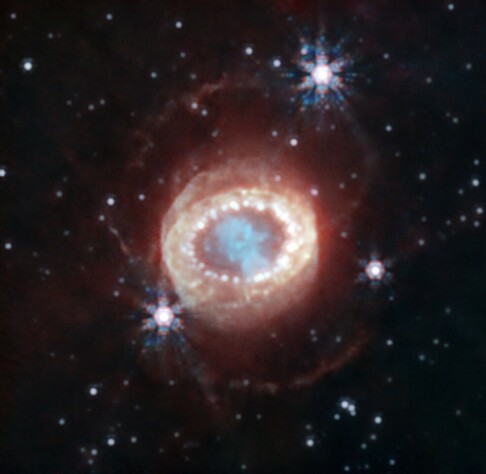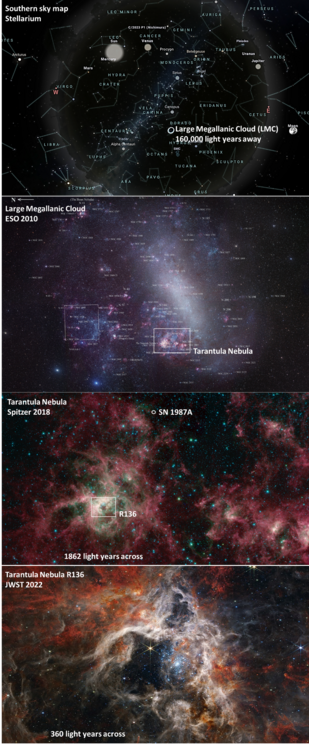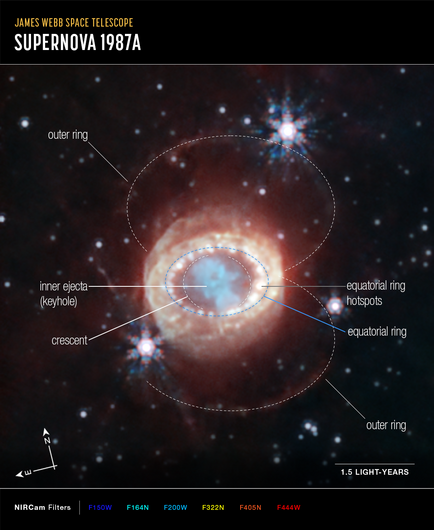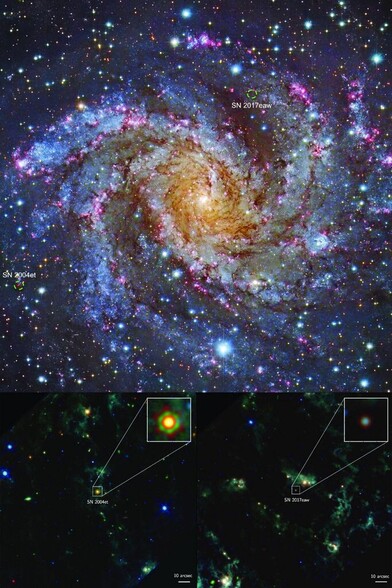AkaSci 🛰️ · @AkaSci
1935 followers · 1878 posts · Server fosstodon.orgHere are a few more images of Supernova 1987A to feast your eyes on 🤩
https://esahubble.org/images/opo9719b/
https://hubblesite.org/contents/media/images/2007/16/2097-Image.html
https://webbtelescope.org/contents/media/images/2019/13/4324-Image
#SN1987A #Chandra
7/n
AkaSci 🛰️ · @AkaSci
1935 followers · 1878 posts · Server fosstodon.orgAstronomers expected SN 1987A to have collapsed into a dense neutron star. But clear evidence for it has been difficult to find.
In 2021, high energy X-ray data from NuSTAR and Chandra provided some evidence for the existence of a structure known as a "pulsar wind nebula" at the center of SN 1987A. A pulsar wind nebula is a cloud of charged particles and magnetic fields created by a rapidly spinning neutron star.
Promising but not definitive.
https://www.nasa.gov/mission_pages/chandra/images/reclusive-neutron-star-may-have-been-found-in-famous-supernova.html
#SN1987A #Chandra
6/n
AkaSci 🛰️ · @AkaSci
1929 followers · 1872 posts · Server fosstodon.orgThese images from Hubble show the evolution of the bright spots on the inner ring around SN 1987A.
After the initial flash of UV radiation, the rings cooled down until they got hit by the shock wave of material ejected by the SN, which compress and heat the gas in the ring, making it glow. Spots started to dim again after 2011.
https://kth.diva-portal.org/smash/get/diva2:1752114/FULLTEXT01.pdf
#SN1987A #Hubble
5/n
AkaSci 🛰️ · @AkaSci
1929 followers · 1872 posts · Server fosstodon.orgThis image of SN 1987A was taken by Hubble in 1990, 3.5 years after the explosion.
The SN was about 0.1 light years in diameter then but the ring radius was estimated at ~0.75 ly.
Scientists speculated that the gas ring was created by the progenitor star 10K years ago. The ring material was ionized and heated by the intense flash of ionizing radiation from the supernova which must have reached the ring within a year after the explosion.
https://hubblesite.org/contents/media/images/1990/17/20-Image.html
#SN1987A #Hubble
4/n
AkaSci 🛰️ · @AkaSci
1929 followers · 1872 posts · Server fosstodon.orgSupernova 1987A was discovered on Feb 24, 1987.
Four days after discovery, its progenitor star was tentatively identified as Sanduleak −69 202, a blue supergiant, a high-mass high luminosity star.
One theory about SN 1987A is that it was a binary star system, in which the smaller companion merged into the more massive star. Subsequently, around 170K years ago, the star went supernova, ejecting matter and shockwaves into the surrounding gas/dust disk.
Fraser Cain · @fraser
3245 followers · 994 posts · Server m.universetoday.comThe Closest Supernova Seen in the Modern Era, Examined by JWST
In 1987, a supernova suddenly appeared in the Large Magellanic Cloud and was studied by astronomers worldwide. Although the detonating star was 165,000 light-years away, this was still the closest supernova seen in centuries. Astronomers have continued to study the expanding debris cloud over the decades, and now JWST has joined the effort, revealing new features never before seen with other observatories. The central core is so dense with gas and dust that its central neutron star remnant is still hidden, even to JWST.
https://www.nasa.gov/feature/goddard/2023/webb-reveals-new-structures-within-iconic-supernova
AkaSci 🛰️ · @AkaSci
1928 followers · 1869 posts · Server fosstodon.orgSupernova SN 1987A is located at the edge of the Tarantula Nebula, which is part of the Large Magellanic Cloud (LMC), a neighboring galaxy, 160K light years away.
See map and zoom-ins below.
AkaSci 🛰️ · @AkaSci
1928 followers · 1868 posts · Server fosstodon.orgNew image of Supernova SN 1987A remnant from the JWST.
SN 1987A, whose explosion was observed in 1987 (it exploded 160K years ago), is one of the most studied objects.
Besides the dust-filled central structure, the bright beaded ring and 2 outer rings, the new image shows 2 faint crescents around the center.
The beaded ring is formed from the SN shockwave hitting material ejected ~20,000 years ago by the progenitor star.
Let's explore SN 1987A.
https://webbtelescope.org/contents/media/images/2023/136/01H8Q0YNFRGYKJC8JM90V1WHSG?news=true
#SN1987A #JWST
1/n
Mr.Trunk · @mrtrunk
10 followers · 18387 posts · Server dromedary.seedoubleyou.meGizmodo: Webb Telescope Spots Eye-Shaped Supernova With a Messy Filling https://gizmodo.com/webb-telescope-eye-shaped-supernova-dusty-core-1850793342?utm_source=regular #supernovaearlywarningsystem #jameswebbspacetelescope #supernovaremnants #stellarevolution #typeiisupernova #supernovae #supernova #sn1987a #orifox #webb
#supernovaearlywarningsystem #jameswebbspacetelescope #supernovaremnants #stellarevolution #typeiisupernova #supernovae #supernova #sn1987a #orifox #webb
Kuuke's Sterrenbeelden · @kuuke
47 followers · 312 posts · Server mastodon.nlWebb ziet stof reservoirs in twee Type IIP supernovae
De stofreservoirs zijn waargenomen in twee type IIP supernova’s, SN 2004et en SN 2017eaw, beide in het middelgrote, face-on spiraalstelsel NGC 6946 op ongeveer 2 miljoen lichtjaar afstand
https://www.kuuke.nl/webb-ziet-stof-reservoirs-in-twee-type-iip-supernovae/
#Webb #supernova #stof #sn1987a #infrarood
Mr.Trunk · @mrtrunk
2 followers · 1831 posts · Server dromedary.seedoubleyou.meGizmodo: Webb Telescope Spots Potential Fuel for Early Universe in Supernovae Debris https://gizmodo.com/webb-telescope-early-universe-fuel-supernovae-debris-1850606363 #jameswebbspacetelescope #hubblespacetelescope #technologyinternet #supernovaremnants #melissashahbandeh #stellarevolution #kenichinomoto #environment #cosmicdust #supernova #astronomy #sn1987a #spitzer #orifox #webb
#jameswebbspacetelescope #hubblespacetelescope #technologyinternet #supernovaremnants #melissashahbandeh #stellarevolution #kenichinomoto #environment #cosmicdust #supernova #astronomy #sn1987a #spitzer #orifox #webb
Tim J · @timtfj
210 followers · 2119 posts · Server mastodon.socialHow's #SN1987a doing these days? #RandomThought #astronomy
#sn1987a #randomthought #astronomy
